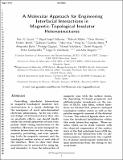Por favor, use este identificador para citar o enlazar a este item:
http://hdl.handle.net/10261/218502COMPARTIR / EXPORTAR:
 SHARE SHARE
 CORE
BASE CORE
BASE
|
|
| Visualizar otros formatos: MARC | Dublin Core | RDF | ORE | MODS | METS | DIDL | DATACITE | |

| Título: | Molecular approach for engineering interfacial interactions in magnetic/topological insulator heterostructures |
Autor: | Cuxart, M. G. CSIC ORCID; Valbuena, Miguel A. CSIC ORCID; Robles, Roberto CSIC ORCID ; Moreno, César CSIC ORCID; Bonell, Fréderic; Sauthier, Guillaume CSIC ORCID; Imaz, Inhar CSIC ORCID; Xu, Heng CSIC; Nistor, Corneliu CSIC; Gargiani, Pierluigi; Valvidares, Manuel; Maspoch, Daniel CSIC ORCID ; Gambardella, Pietro | Fecha de publicación: | 2020 | Editor: | American Chemical Society | Citación: | ACS Nano 14(5): 6285–6294 (2020) | Resumen: | Controlling interfacial interactions in magnetic/topological insulator heterostructures is a major challenge for the emergence of novel spin-dependent electronic phenomena. As for any rational design of heterostructures that rely on proximity effects, one should ideally retain the overall properties of each component while tuning interactions at the interface. However, in most inorganic interfaces, interactions are too strong, consequently perturbing, and even quenching, both the magnetic moment and the topological surface states at each side of the interface. Here, we show that these properties can be preserved using ligand chemistry to tune the interaction of magnetic ions with the surface states. By depositing Co-based porphyrin and phthalocyanine monolayers on the surface of Bi2Te3 thin films, robust interfaces are formed that preserve undoped topological surface states as well as the pristine magnetic moment of the divalent Co ions. The selected ligands allow us to tune the interfacial hybridization within this weak interaction regime. These results, which are in stark contrast with the observed suppression of the surface state at the first quintuple layer of Bi2Se3 induced by the interaction with Co phthalocyanines, demonstrate the capability of planar metal–organic molecules to span interactions from the strong to the weak limit. | Versión del editor: | https://doi.org/10.1021/acsnano.0c02498 | URI: | http://hdl.handle.net/10261/218502 | DOI: | 10.1021/acsnano.0c02498 | ISSN: | 1936-0851 | E-ISSN: | 1936-086X |
| Aparece en las colecciones: | (CFM) Artículos (CIN2) Artículos |
Ficheros en este ítem:
| Fichero | Descripción | Tamaño | Formato | |
|---|---|---|---|---|
| acsnano_a2020v14np6285-Post.pdf | 5,3 MB | Adobe PDF |  Visualizar/Abrir |
CORE Recommender
SCOPUSTM
Citations
9
checked on 18-abr-2024
WEB OF SCIENCETM
Citations
8
checked on 24-feb-2024
Page view(s)
227
checked on 23-abr-2024
Download(s)
72
checked on 23-abr-2024
Google ScholarTM
Check
Altmetric
Altmetric
NOTA: Los ítems de Digital.CSIC están protegidos por copyright, con todos los derechos reservados, a menos que se indique lo contrario.
